
The Philippine Scouts (Filipino: Maghahanap ng Pilipinas/Hukbong Maghahanap ng Pilipinas) was a military organization of the United States Army from 1901 until after the end of World War II. These troops were generally Filipinos and Filipino-Americans assigned to the United States Army Philippine Department, under the command of American commissioned officers (though a handful of Filipino Americans received commissions from the United States Military Academy). Philippine Scout units were given the suffix "(PS)", to distinguish them from other U.S. Army units.

The Bataan Death March was the forcible transfer by the Imperial Japanese Army of around 75,000 American and Filipino prisoners of war (POW) from the municipalities of Bagac and Mariveles on the Bataan Peninsula to Camp O'Donnell via San Fernando.

The Raid at Cabanatuan, also known as the Great Raid, was a rescue of Allied prisoners of war (POWs) and civilians from a Japanese camp near Cabanatuan, Nueva Ecija, Philippines. On January 30, 1945, during World War II, United States Army Rangers, Alamo Scouts and Filipino guerrillas attacked the camp and liberated more than 500 prisoners.

Ghost Soldiers: The Epic Account of World War II's Greatest Rescue Mission is a non-fiction book written by Hampton Sides. It is about the World War II Allied prison camp raid at Cabanatuan in the Philippines.
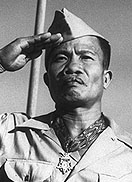
Jose Cabalfin Calugas was a member of the Philippine Scouts during World War II. He received the Medal of Honor for actions during the Battle of Bataan.

Margaret Elizabeth Doolin "Peggy" Utinsky was an American nurse who worked with the Filipino resistance movement to provide medicine, food, and other items to aid Allied prisoners of war in the Philippines during World War II. She was recognized in 1946 with the Medal of Freedom for her actions.

Camp O'Donnell is a current military base and former United States military reservation in the Philippines located on Luzon island in the municipality of Capas in Tarlac. It housed the Philippine Army's newly created 71st Division and after the Americans' return, a United States Army camp. During World War II, the reservation was used as a prisoner-of-war camp for Filipino and American soldiers captured by Japan during its successful invasion of the Philippines. About 60,000 Filipino and 9,000 Americans were housed at the camp. During the few months in 1942 that Camp O'Donnell was used as a prisoner-of-war camp, about 20,000 Filipinos and 1,500 Americans died there of disease, starvation, neglect, and brutality.
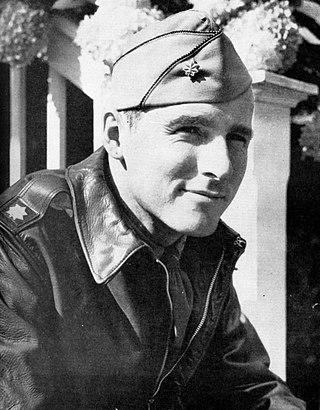
William Edwin Dyess was an officer of the United States Army Air Forces during World War II. He was captured after the Allied loss at the Battle of Bataan and endured the subsequent Bataan Death March. After a year in captivity, Dyess escaped and spent three months on the run before being evacuated from the Philippines by a U.S. submarine. Once back in the U.S., he recounted the story of his capture and imprisonment, providing the first widely published eye-witness account of the brutality of the death march. He returned to duty in the Army Air Forces, but was killed in a training accident months later.

Back to Bataan is a 1945 American black-and-white World War II war film drama from RKO Radio Pictures, produced by Robert Fellows, directed by Edward Dmytryk, that stars John Wayne and Anthony Quinn. The film depicts events that took place after the Battle of Bataan (1941–42) on the island of Luzon in the Philippines. The working title of the film was The Invisible Army.
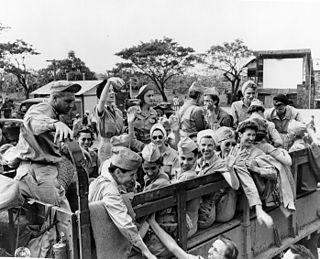
The Angels of Bataan were the members of the United States Army Nurse Corps and the United States Navy Nurse Corps who were stationed in the Philippines at the outset of the Pacific War and served during the Battle of the Philippines (1941–1942). When Bataan and Corregidor fell, 11 navy nurses, 66 army nurses, and 1 nurse-anesthetist were captured and imprisoned in and around Manila. They continued to serve as a nursing unit while prisoners of war. They were freed in February 1945.
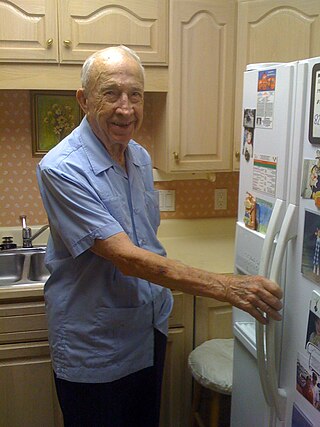
John Eric Olson was a U.S. Army Colonel, West Point graduate, and one of the last surviving officers of the Bataan Death March of World War II. He was also a military historian and author of three books, as well as numerous magazine articles dealing primarily with his experiences as a prisoner of war in the Philippines and in Japan from 1942 to 1945.

Camp Barkeley was a large United States Army training installation during World War II. The base was located eleven miles (18 km) southwest of Abilene, Texas, near what is now Dyess Air Force Base. The base was named after David B. Barkley, a Medal of Honor recipient during World War I. The camp was 70,229 acres (284.21 km2) in size and had a population of 50,000 at its peak of operation.

Jack L. Hawkins was a United States Marines Corps colonel employed by the CIA for the military planning, training of Cuban exiles, and the effective military command of forces in the Bay of Pigs Invasion of Cuba in April 1961. Hawkins was known by the alias John Haskins.
Mario George Tonelli was a professional American football player who played running back for one season for the Chicago Cardinals. He was drafted in the 21st round of the 1939 NFL Draft.
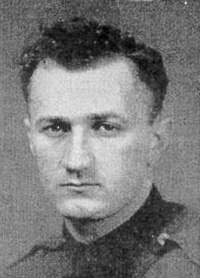
Samuel Charles Grashio was a United States Army Air Forces pilot who was captured by the Japanese in World War II. He survived the Bataan Death March and participated in the only successful mass escape from a Japanese prison camp.

The Palawan massacre occurred on 14 December 1944, during World War II, near the city of Puerto Princesa in the Philippine province of Palawan. Allied soldiers, imprisoned near the city, were killed by Imperial Japanese soldiers. Only eleven men managed to survive, while 139 were killed.

Brigadier General Austin Conner Shofner was a United States Marine Corps officer who was captured during the Battle of Corregidor and then part of the only successful escape from a Japanese prisoner of war camp. He joined the Philippine resistance, and later returned to command units of the Marine Corps in the battles of Peleliu and Okinawa.

During the Japanese occupation of the islands in World War II, there was an extensive Philippine resistance movement, which opposed the Japanese and their collaborators with active underground and guerrilla activity that increased over the years. Fighting the guerrillas – apart from the Japanese regular forces – were a Japanese-formed Bureau of Constabulary, the Kenpeitai, and the Makapili. Postwar studies estimate that around 260,000 people were organized under guerrilla groups and that members of anti-Japanese underground organizations were more numerous. Such was their effectiveness that by the end of World War II, Japan controlled only twelve of the forty-eight provinces.

Davao Prison and Penal Farm, formerly the Davao Penal Colony (DaPeCol), is a medium security prison located in Panabo City, Davao del Norte, Philippines. It has a land area of 30,000 hectares with a prison reservation of 8,000 hectares. Established on January 21, 1932, the Davao Penal Colony was the largest prison establishment in the country which the invading Japanese Army used as their imperial garrison during World War II.


















